
Space food
Encyclopedia
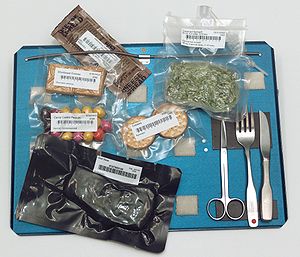
Food processing
Food processing is the set of methods and techniques used to transform raw ingredients into food or to transform food into other forms for consumption by humans or animals either in the home or by the food processing industry...
for consumption by astronaut
Astronaut
An astronaut or cosmonaut is a person trained by a human spaceflight program to command, pilot, or serve as a crew member of a spacecraft....
s in outer space
Outer space
Outer space is the void that exists between celestial bodies, including the Earth. It is not completely empty, but consists of a hard vacuum containing a low density of particles: predominantly a plasma of hydrogen and helium, as well as electromagnetic radiation, magnetic fields, and neutrinos....
. The food has specific requirements of providing balanced nutrition for the health of individuals working in space, while being easy and safe to store, prepare and consume in the machinery filled low gravity
Weightlessness
Weightlessness is the condition that exists for an object or person when they experience little or no acceleration except the acceleration that defines their inertial trajectory, or the trajectory of pure free-fall...
environments of contemporary manned spacecraft
Spacecraft
A spacecraft or spaceship is a craft or machine designed for spaceflight. Spacecraft are used for a variety of purposes, including communications, earth observation, meteorology, navigation, planetary exploration and transportation of humans and cargo....
. In recent years, space food has been used by various nations engaging on space programs as a way to share and show off their cultural identity
Cultural identity
Cultural identity is the identity of a group or culture, or of an individual as far as one is influenced by one's belonging to a group or culture. Cultural identity is similar to and has overlaps with, but is not synonymous with, identity politics....
and facilitate intercultural communication
Intercultural communication
Intercultural communication is a form of global communication. It is used to describe the wide range of communication problems that naturally appear within an organization made up of individuals from different religious, social, ethnic, and educational backgrounds. Intercultural communication is...
.
Early history
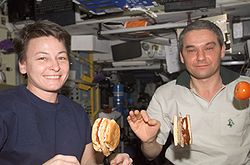
Vostok (1961)
For lunch Gagarin ate three 160 g toothpaste-type tubes. Two servings of puréed meat and one chocolate sauce.http://www.astronautix.com/flights/vostok1.htmApollo-Soyuz Test Project (1975)

Apollo-Soyuz Test Project
-Backup crew:-Crew notes:Jack Swigert had originally been assigned as the command module pilot for the ASTP prime crew, but prior to the official announcement he was removed as punishment for his involvement in the Apollo 15 postage stamp scandal.-Soyuz crew:...
received samples of Soviet space food when the combined crew dined together. Among the foods provided by Soyuz 19 were canned
Canning
Canning is a method of preserving food in which the food contents are processed and sealed in an airtight container. Canning provides a typical shelf life ranging from one to five years, although under specific circumstances a freeze-dried canned product, such as canned, dried lentils, can last as...
beef tongue
Beef tongue
Beef tongue is the tongue of a cow. The human consumption of beef tongue dates back to the days of Paleolithic hunters, who preferred the fatty portions of the carcass including tongues, as well as organs, brains, feet, and marrow. Beef tongue is very high in fat, at almost 75% of its calories...
, packaged Riga bread
Bread
Bread is a staple food prepared by cooking a dough of flour and water and often additional ingredients. Doughs are usually baked, but in some cuisines breads are steamed , fried , or baked on an unoiled frying pan . It may be leavened or unleavened...
, and tubes of borscht
Borscht
Borscht is a soup of Ukrainian origin that is popular in many Eastern and Central European countries. In most of these countries, it is made with beetroot as the main ingredient, giving it a deep reddish-purple color...
and caviar
Caviar
Caviar, sometimes called black caviar, is a luxury delicacy, consisting of processed, salted, non-fertilized sturgeon roe. The roe can be "fresh" or pasteurized, the latter having much less culinary and economic value....
. The borscht was labeled "vodka
Vodka
Vodka , is a distilled beverage. It is composed primarily of water and ethanol with traces of impurities and flavorings. Vodka is made by the distillation of fermented substances such as grains, potatoes, or sometimes fruits....
" as a joke.
United States
One of John GlennJohn Glenn
John Herschel Glenn, Jr. is a former United States Marine Corps pilot, astronaut, and United States senator who was the first American to orbit the Earth and the third American in space. Glenn was a Marine Corps fighter pilot before joining NASA's Mercury program as a member of NASA's original...
's many tasks, as the first American to orbit Earth in 1962, was to experiment with eating in weightless conditions. Some experts had been concerned that weightlessness would impair swallowing. Glenn experienced no difficulties and it was determined that microgravity did not affect the natural swallowing process.
Project Mercury (1959-1963)
Astronauts in later Mercury missionsProject Mercury
In January 1960 NASA awarded Western Electric Company a contract for the Mercury tracking network. The value of the contract was over $33 million. Also in January, McDonnell delivered the first production-type Mercury spacecraft, less than a year after award of the formal contract. On February 12,...
disliked the food that was provided. They ate bite-sized cubes, freeze-dried powders, and tubes of semiliquids. The astronauts found it unappetizing, experienced difficulties in rehydrating the freeze-dried foods, and didn't like having to squeeze tubes or collect crumbs.
Project Gemini (1965-1966)
Several of the food issues from the Mercury missions were addressed for the later Gemini missionsProject Gemini
Project Gemini was the second human spaceflight program of NASA, the civilian space agency of the United States government. Project Gemini was conducted between projects Mercury and Apollo, with ten manned flights occurring in 1965 and 1966....
. Tubes (often heavier than the foods they contained) were abandoned. Gelatin coatings helped to prevent bite-sized cubes from crumbling. Simpler rehydration methods were developed. The menus also expanded to include items such as shrimp cocktail, chicken and vegetables, toast squares, butterscotch pudding, and apple juice.
The crew of Gemini III sneaked a corned beef sandwich on their spaceflight. Mission Commander Gus Grissom
Gus Grissom
Virgil Ivan Grissom , , better known as Gus Grissom, was one of the original NASA Project Mercury astronauts and a United States Air Force pilot...
loved corned beef sandwiches, so Pilot John Young brought one along, having been encouraged by fellow astronaut Walter Schirra. However, Young was supposed to only eat approved food, and Grissom wasn't supposed to eat anything. Floating pieces of bread posed a potential problem, causing Grissom to put the sandwich away (although he did enjoy it) and the astronauts were mildly rebuked by NASA
NASA
The National Aeronautics and Space Administration is the agency of the United States government that is responsible for the nation's civilian space program and for aeronautics and aerospace research...
for the act. A congressional hearing was called, forcing the NASA deputy administrator George Mueller
George Mueller (NASA)
George Mueller was Associate Administrator of the NASA Office of Manned Space Flight from September 1963 until December 1969...
to promise no repeats. NASA took special care about what astronauts brought along on future missions.
Apollo program (1968-1975)
The variety of food options continued to expand for the Apollo missions. The new availability of hot water made rehydrating freeze-dried foods simpler, and produced a more appetizing result. The "spoon-bowl" allowed more normal eating practices. Food could be kept in special plastic zip-closure containers, and its moisture allowed it to stick to a spoon.Skylab (1973-1974)
Larger living areas on the SkylabSkylab
Skylab was a space station launched and operated by NASA, the space agency of the United States. Skylab orbited the Earth from 1973 to 1979, and included a workshop, a solar observatory, and other systems. It was launched unmanned by a modified Saturn V rocket, with a mass of...
space station allowed for an on-board refrigerator and freezer, which allowed perishable and frozen items to be stored and made the microgravity the primary obstacle. When Skylab's solar panels were damaged during its launch and the station had to rely on minimal power from the Apollo Telescope Mount
Apollo Telescope Mount
The Apollo Telescope Mount, or ATM, is the name of a solar observatory that was attached to Skylab, the first US space station.The ATM was one of a number of projects that came out of the late 1960s Apollo Applications Program, which studied a wide variety of ways to use the infrastructure...
until Skylab 2
Skylab 2
-Backup crew:-Support crew:*Robert L. Crippen*Richard H. Truly*Henry W. Hartsfield, Jr*William E. Thornton-Mission parameters:*Mass: 19,979 kg*Maximum Altitude: 440 km*Distance: 18,536,730.9 km...
crewmembers performed repairs, the refrigerator and freezer were among the systems that Mission Control kept operational.
Menus included items such as processed meat products and ice cream. A dining room table and chairs, fastened to the floor and fitted with foot and thigh restraints, allowed for a more normal eating experience. The trays used could warm the food, and had magnets to hold eating utensils and scissors to open food containers. The crews found the food to be better than Apollo's but still mediocre due, in part, to it tasting different in space from on Earth. They liked the frozen foods the best, and found they desired spicy foods due to head congestion from weightlessness dulling their senses of taste and smell. Weightlessness also complicated both eating and cleaning up; crews spent up to 90 minutes a day on housekeeping.
Modern
Today, fruits and vegetables that can be safely stored at room temperature are eaten on space flights. Astronauts also have a greater variety of main courseMain course
A main dish is the featured or primary dish in a meal consisting of several courses. It usually follows the entrée course, and the salad course. In North American usage it may in fact be called the "entree"....
s to choose from, and many request personalized menus from lists of available foods including items like fruit salad and spaghetti. Astronauts sometimes request beef jerky
Jerky (food)
Jerky is lean meat that has been trimmed of fat, cut into strips, and then been dried to prevent spoilage. Normally, this drying includes the addition of salt, to prevent bacteria from developing on the meat before sufficient moisture has been removed. The word "jerky" is a bastardization of the...
for flights, as it is lightweight, nutritious, and can be consumed in orbit without packaging or other changes.
- Chinese: In October 2003, the People's Republic of ChinaPeople's Republic of ChinaChina , officially the People's Republic of China , is the most populous country in the world, with over 1.3 billion citizens. Located in East Asia, the country covers approximately 9.6 million square kilometres...
commenced their first manned space flight. The astronaut, Yang LiweiYang LiweiYáng Lìwěi is a Chinese major general and military pilot and a CNSA astronaut. He was the first man sent into space by the Chinese space program and his mission, Shenzhou 5, made China the third country to independently send people into space.-Background:...
, brought along with him and ate specially processed yuxiangYuxiangYuxiang is a seasoning mixture in Chinese cuisine, and also refers to the resulting sauce in which meat or vegetables are cooked in. It is said to have originated in Sichuan cuisine, but has since spread to other regional Chinese cuisines...
pork (鱼香肉丝), Kung Pao chickenKung Pao chickenGong Bao chicken , a late Qing Dynasty official. Born in Guizhou, Ding served as head of Shandong province and later as governor of Sichuan province. His title was Gōng Bǎo , or palatial guardian. The name "Kung Pao" chicken is derived from this title....
(宫保鸡丁), and Eight Treasures rice (simp: 八宝饭; trad: 八寶飯), along with Chinese herbal tea. Food made for this flight and the subsequent manned flight in 2007 has been commercialized for sale to the mass market.
- Japanese: The Japan Aerospace Exploration AgencyJapan Aerospace Exploration AgencyThe , or JAXA, is Japan's national aerospace agency. Through the merger of three previously independent organizations, JAXA was formed on October 1, 2003, as an Independent Administrative Institution administered by the Ministry of Education, Culture, Sports, Science and Technology and the...
(JAXA) have developed traditional Japanese foods and drinks such as matchaMatcharefers to finely-milled green tea, most popular in Japan. The cultural activity called the Japanese tea ceremony centers on the preparation, serving, and drinking of matcha. In modern times, matcha has also come to be used to flavour and dye foods such as mochi and soba noodles, green tea ice cream...
, yokanYokanis a thick jellied dessert made of red bean paste, agar, and sugar. It is usually sold in a block form, and eaten in slices. There are two main types: neri yōkan and mizu yōkan. "Mizu" means "water", and indicates that it is made with more water than usual...
, ramenRamenis a Japanese noodle dish. It consists of Chinese-style wheat noodles served in a meat- or fish-based broth, often flavored with soy sauce or miso, and uses toppings such as , , kamaboko, green onions, and occasionally corn...
, sushiSushiis a Japanese food consisting of cooked vinegared rice combined with other ingredients . Neta and forms of sushi presentation vary, but the ingredient which all sushi have in common is shari...
, soups, rice with umeUmePrunus mume, with the common names including Chinese plum and Japanese apricot, is an Asian tree species classified in the Armeniaca section of the genus Prunus. The flower, long a beloved subject in the traditional painting of East Asia, is usually translated as plum blossom. This distinct tree...
for consumption in orbit. The foods have been produced in collaboration with Japanese food companies such as AjinomotoAjinomotoAjinomoto Co. Inc. , is a Japanese food and chemical corporation which produces seasonings, cooking oils, TV dinners, sweeteners, amino acids and pharmaceuticals...
, Meiji DairiesMeiji Dairiesis the trade name of a food company in Japan, , until March 31, 2011.It was a major dairy industry company established in 1917. Apart from dairy products like milk, ice cream, and cheese, their lineup includes sports drinks, pizza, chocolate bars and food supplements like "Toromeiku", described as...
, and Nissin Foods.
- Jewish: In June 2008, Gregory ChamitoffGregory ChamitoffGregory Errol Chamitoff is an engineer and NASA astronaut. He was assigned to Expedition 17 and flew to the International Space Station on STS-124, launching 31 May 2008. He was in space 198 days, joining Expedition 18 after Expedition 17 left the station, and returned to Earth 30 November 2008 on...
brought bagelBagelA bagel is a bread product, traditionally shaped by hand into the form of a ring from yeasted wheat dough, roughly hand-sized, which is first boiled for a short time in water and then baked. The result is a dense, chewy, doughy interior with a browned and sometimes crisp exterior...
s into space for the first time. He was on STS-124STS-124STS-124 was a Space Shuttle mission, flown by Space Shuttle Discovery to the International Space Station. Discovery launched on 31 May 2008 at 17:02 EDT, moved from an earlier scheduled launch date of 25 May 2008, and landed safely at the Kennedy Space Center's Shuttle Landing Facility, at 11:15...
for ISSInternational Space StationThe International Space Station is a habitable, artificial satellite in low Earth orbit. The ISS follows the Salyut, Almaz, Cosmos, Skylab, and Mir space stations, as the 11th space station launched, not including the Genesis I and II prototypes...
Expedition 17Expedition 17Expedition 17 was the 17th expedition to the International Space Station .The first two crew members, Sergey Volkov, and Oleg Kononenko were launched on 8 April 2008, aboard the Soyuz TMA-12...
, and brought with him 18 sesame seed Montreal-style bagels from his cousin's bakery.
- Korean: In April 2008, South KoreaSouth KoreaThe Republic of Korea , , is a sovereign state in East Asia, located on the southern portion of the Korean Peninsula. It is neighbored by the People's Republic of China to the west, Japan to the east, North Korea to the north, and the East China Sea and Republic of China to the south...
’s first astronaut, Yi So-yeonYi So-yeonYi So-yeon is a South Korean scientist and Ph.D. graduate of KAIST . On April 8, 2008, she became the first Korean and the second Asian woman to fly in space, after Chiaki Mukai.-Biography:Yi So-yeon was born to father Yi Gil-soo...
, was a crew member on the International Space StationInternational Space StationThe International Space Station is a habitable, artificial satellite in low Earth orbit. The ISS follows the Salyut, Almaz, Cosmos, Skylab, and Mir space stations, as the 11th space station launched, not including the Genesis I and II prototypes...
and brought a special version of Korea's national dish, kimchiKimchiKimchi , also spelled gimchi, kimchee, or kim chee, is a traditional fermented Korean dish made of vegetables with varied seasonings. There are hundreds of varieties of kimchi made with a main vegetable ingredient such as napa cabbage, radish, green onions or cucumber. It is the most common...
. It took three research institutes several years and millions of dollars to create a version of the fermented cabbage dish that was suitable for space travel.
- Russian: On the ISS the Russian crew has a selection of over 300 dishes. An example daily menu can be:
- Breakfast: curds and nuts, mashed potatoes with nuts, apple-quince chip sticks, sugarless coffee and vitamins.
- Lunch: jellied pike perch, borsch with meat, goulash with buckwheat, bread, black currant juice, sugarless tea.
- Supper: rice and meat, broccoli and cheese, nuts, tea with sugar.
- Second supper: dried beef, cashew nuts, peaches, grape juice.
- Swedish: Swedish astronaut Christer FuglesangChrister FuglesangDr. Arne Christer Fuglesang is a Swedish physicist and an ESA astronaut. He was first launched aboard the STS-116 Space Shuttle mission on December 10, 2006, at 01:47 GMT, making him the first Swedish citizen in space....
was not allowed to bring reindeer jerky with him on-board a shuttle mission as it was unthinkable for the Americans so soon before Christmas. He had to go with moose instead.
Processing
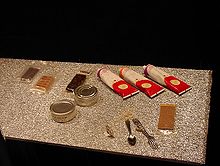
Physiology
Physiology is the science of the function of living systems. This includes how organisms, organ systems, organs, cells, and bio-molecules carry out the chemical or physical functions that exist in a living system. The highest honor awarded in physiology is the Nobel Prize in Physiology or...
appropriate, specifically, it must be nutritious, easily digestible, and palatable. Second, the food must be engineered for consumption in a zero gravity
Weightlessness
Weightlessness is the condition that exists for an object or person when they experience little or no acceleration except the acceleration that defines their inertial trajectory, or the trajectory of pure free-fall...
environment. As such, the food should be light, well packaged, quick to serve, and easy to clean up (foods that tend to leave crumbs, for example, are ill-suited for space). Finally, foods must require a minimum of energy expenditure throughout their use, i.e., they should store well, open easily, and leave little waste behind.
Carbonation
Carbonated drinks have been tried in space, but are not favored due to changes in belching caused by microgravity. Coca-ColaCoca-Cola
Coca-Cola is a carbonated soft drink sold in stores, restaurants, and vending machines in more than 200 countries. It is produced by The Coca-Cola Company of Atlanta, Georgia, and is often referred to simply as Coke...
and Pepsi
Pepsi
Pepsi is a carbonated soft drink that is produced and manufactured by PepsiCo...
were first carried on STS-51-F
STS-51-F
STS-51-F was the nineteenth flight of NASA's Space Shuttle program, and the eighth flight of Space Shuttle Challenger...
in 1985. Coca-Cola has flown on subsequent missions in a specially-designed dispenser that utilizes BioServe Space Technologies hardware used for biochemical experiments. Space Station Mir carried cans of Pepsi in 1996.
Beer
Beer
Beer is the world's most widely consumed andprobably oldest alcoholic beverage; it is the third most popular drink overall, after water and tea. It is produced by the brewing and fermentation of sugars, mainly derived from malted cereal grains, most commonly malted barley and malted wheat...
has also been developed that counteract the reduction of taste and smell reception in space and reduce the possibility of wet burps in microgravity. Produced by Vostok 4-Pines Stout, a parabolic flight experiment validated that the reduced carbonation recipe was met the criteria intended for space. Barley harvested from that grown for several generations in space have also been brought back to earth to produce beer. While not a space food (it used the same high carbonation 'Earth' recipe), the study did demonstrate that ingredients grown in space are safe for production.
Packaging
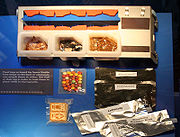
English language
English is a West Germanic language that arose in the Anglo-Saxon kingdoms of England and spread into what was to become south-east Scotland under the influence of the Anglian medieval kingdom of Northumbria...
and Russian
Russian language
Russian is a Slavic language used primarily in Russia, Belarus, Uzbekistan, Kazakhstan, Tajikistan and Kyrgyzstan. It is an unofficial but widely spoken language in Ukraine, Moldova, Latvia, Turkmenistan and Estonia and, to a lesser extent, the other countries that were once constituent republics...
.
Many foods from the Russian space program
Russian Federal Space Agency
The Russian Federal Space Agency , commonly called Roscosmos and abbreviated as FKA and RKA , is the government agency responsible for the Russian space science program and general aerospace research. It was previously the Russian Aviation and Space Agency .Headquarters of Roscosmos are located...
are packaged in can
Tin can
A tin can, tin , steel can, or a can, is a sealed container for the distribution or storage of goods, composed of thin metal. Many cans require opening by cutting the "end" open; others have removable covers. Cans hold diverse contents: foods, beverages, oil, chemicals, etc."Tin" cans are made...
s and tins. These are heated through electro-resistive (ohmic) methods, opened with a can-opener, and the food inside consumed directly. Russian soups are hydrated and consumed directly from their packages.
NASA space foods are packaged in retort pouch
Retort pouch
A retort pouch is a type of food packaging created by aseptic processing, made from multiple layers of flexible laminate, allowing for the sterile packaging of a wide variety of food and drink, ranging from water to fully cooked, thermo-stabilized high-caloric meals such as Meals, Ready-to-Eat ...
es or employ freeze drying. They are also packaged in sealed containers which fit into trays to keep them in place. The trays include straps on the underside, allowing astronauts to attach the tray to an anchor point such as their legs or a wall surface and include clips for retaining a beverage pouch or utensils in the microgravity environment.
Types
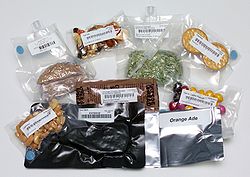
- Beverages (B) - Various rehydratable drinks.
- Fresh Foods (FF)- Foods that spoil quickly that needs to be eaten within the first two days of flight to prevent spoilage.
- Irradiated (I) Meat - Beef steak that is sterilized with ionizing radiation to keep the food from spoiling.
- Intermediate Moisture (IM) - Foods that have some moisture but not enough to cause immediate spoilage.
- Natural Form (NF) - Mostly unprocessed foods such as nuts, cookies and granola bars that are ready to eat.
- Rehydratable (R) Foods - Foods that have been dehydrated and allowed to rehydrate in hot water prior to consumption.
- Thermostabilized (T) - Foods that have been processed with heat to destroy microorganisms and enzymes that may cause spoilage.
More common staples and condiments do not have a classification and are known simply by the item name:
- Shelf Stable Tortillas - Tortillas that have been heat treated and specially packaged in an oxygenOxygenOxygen is the element with atomic number 8 and represented by the symbol O. Its name derives from the Greek roots ὀξύς and -γενής , because at the time of naming, it was mistakenly thought that all acids required oxygen in their composition...
-free nitrogenNitrogenNitrogen is a chemical element that has the symbol N, atomic number of 7 and atomic mass 14.00674 u. Elemental nitrogen is a colorless, odorless, tasteless, and mostly inert diatomic gas at standard conditions, constituting 78.08% by volume of Earth's atmosphere...
atmosphere to prevent the growth of mold. - Condiments - Liquid salt solution, oily pepper paste, mayonnaise, ketchup, and mustard.
Consumer derivatives
Capitalizing on the popularity of the Apollo space missions, Pillsbury marketed "Food Sticks" (also known as "Space Food SticksSpace Food Sticks
Space Food Sticks are snacks originally created for the Pillsbury Company in the late 1960s by the company's chief food technologist Howard Bauman who later was instrumental in establishing the HACCP regulations used for food safety....
") for the consumer market in the early 1970s. Fourteen individually-packaged sticks were included in a box, and came in six flavors such as peanut butter, caramel, and chocolate. Food Sticks were marketed as a "nutritionally balanced between meal snack".
Most of these products can now be found in novelty shops or at Army Surplus locations. Campers have taken to using products such as Tang due to their reliability, but some others, such as many of the freeze dried foods, contain fragrances that can attract bears, cougars, and other forest animals.
Tang
Tang (drink)
Tang is a fruit-flavored breakfast drink. Originally formulated by General Foods Corporation food scientist William A. Mitchell in 1957, it was first marketed in powdered form in 1959....
, originally marketed in 1959, also saw an increase in popularity during this era due to its inclusion on the manned space flights.

